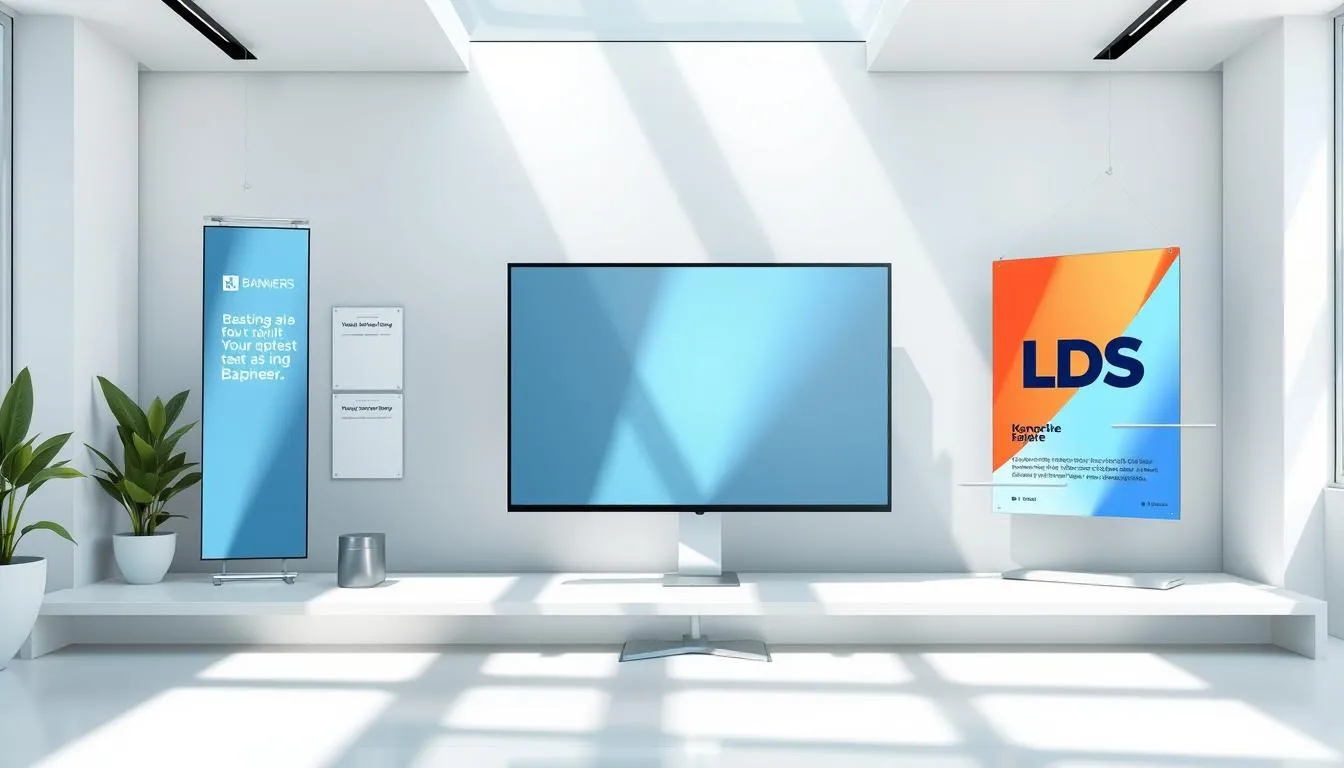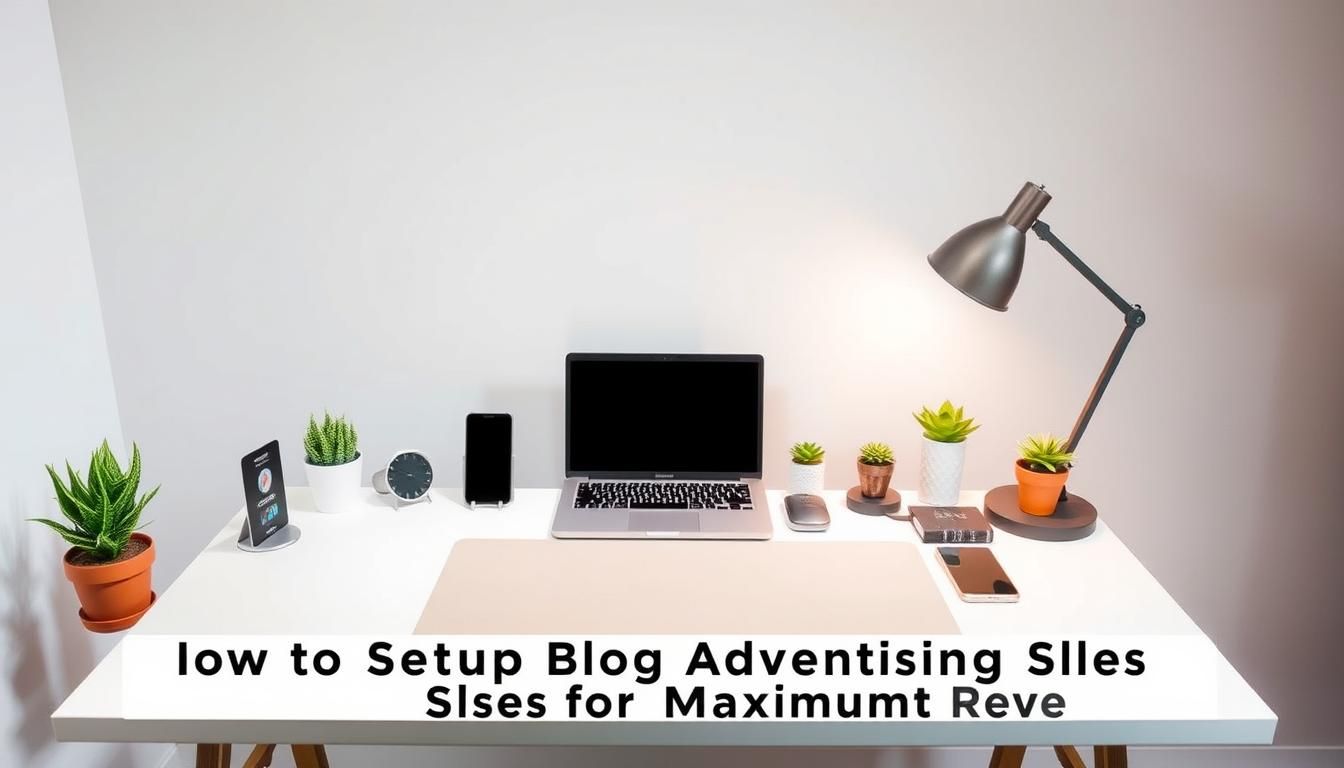72% of publishers report display ad viewability that changes earnings more than layout tweaks — a reminder that placement wins as much as traffic.
This short guide shows a clear, step-by-step path to set up ad units so you can make money without hurting reader experience.
We’ll cover choosing the right networks for your traffic level, where to place ad code (usually in the theme head or via plugins), and which formats earn best over time.
Expect a practical slot map, legal checklist, and simple tests to boost RPM and CTR. You’ll see when to start with Google AdSense and when to scale to networks like Monumetric, Mediavine, or AdThrive.
For a quick deep dive on placement tactics and sizes, check this ad placement guide to match formats with your layout.
Key Takeaways
- Follow a simple slot map that balances ads and readability to grow revenue.
- Start with AdSense if traffic is small; move to premium networks as sessions rise.
- Place code in the head or use plugins so ads load reliably and fast.
- Test header, in-content, sticky, and sidebar placements for best RPM and CTR.
- Keep legal items current: privacy, cookie consent, and FTC disclosures build trust.
Why Ad Slots Matter Now: Revenue, UX, and Passive Income
Well-placed ads convert existing traffic into steady income with minimal daily effort.
Display units operate on CPC or CPM models, so impressions and clicks scale revenue as traffic grows. To complement your advertising revenue, consider exploring building wealth with evergreen affiliate pillars for additional income streams. Premium networks often add hands-on optimization that boosts RPM over time.
Good user experience matters: fewer, thoughtful placements keep readers on the page longer. That raises viewability and improves long-term earnings.
“Small layout improvements can lift RPM more than adding more units.” Industry insight
- Well‑planned ad placement creates passive income while you focus on content.
- Intrusive formats frustrate users and reduce engagement and advertiser demand.
- Device‑specific rules and fast pages compound gains before traffic surges.
| Factor | Impact | Action |
|---|---|---|
| Placement quality | Higher RPM, better viewability | Prioritize in‑content and header anchors |
| Page experience | More engaged audience | Reduce clutter, speed up load time |
| Network support | Improved optimization | Consider premium partners as traffic grows |
Pre‑Setup Essentials: Platform, Policies, and Traffic Readiness
Before you add any ad code, confirm your platform and legal pages are ready for review. Networks and reviewers look for clear navigation, a stable host, and visible policies before approving monetization.

Choosing WordPress.org vs. WordPress.com for ad freedom
WordPress.org (self‑hosted) gives full control to place third‑party code and plugins. That freedom speeds implementation and troubleshooting.
WordPress.com restricts third‑party ads unless you upgrade or use WordAds. Pick the platform that matches your long‑term ad and network plans.
Legal must‑haves and traffic readiness
Make sure your privacy policy, cookie consent, and FTC affiliate disclosure are live and linked from every page. Many networks ask for 10–20 quality posts and clear navigation before approving monetization.
- Set up GA4 and Search Console for basic metrics. For advanced analytics insights that can help optimize your ad performance, explore our guide on advanced traffic analytics dashboards.
- Use SSL, fast hosting, and a lightweight theme.
- Plan where ad code will live (theme head or plugin) for clean governance.
| Checklist | Why it matters | Quick action |
|---|---|---|
| Platform choice | Affects ad freedom and code placement | Pick WordPress.org for full control |
| Legal pages | Required for network approval | Publish privacy, cookie, and FTC disclosure |
| Content & traffic | Shows site value and steady impressions | Have 10–20 strong posts and stable traffic |
Ad Types and When to Use Them
Not every ad type fits every page; match formats to traffic, intent, and content length.
CPC vs CPM display ads: CPC units pay per click while CPM pays per thousand impressions. For low traffic, CPC can reward targeted clicks. As traffic grows, CPM scales better because impressions compound revenue. Networks like AdSense manage both models and ease implementation.

CPC and CPM: traffic, impressions, and payout dynamics
Tip: Improve viewability and long article engagement to raise RPM. Above‑the‑fold helps, but tasteful in‑article slots often convert better.
Flat‑fee direct banners
Direct banners sell by time and audience. Use them when your niche has a clear target and predictable impressions. Marketplaces like BuySellAds speed finding buyers. Flat fees give predictable monthly income versus variable network cost models.
Affiliate links and action‑based ads
Affiliates pay per conversion and can deliver high commission—WP Engine is a strong example with sizable payouts. Use affiliate marketing alongside display ads to diversify revenue. Always add visible disclosures to keep trust and meet legal rules. For comprehensive guidance on transparency best practices, read our article on understanding blog income transparency.
Sponsored content vs display
Sponsored articles often pay more but must be labeled clearly. Balance sponsored work with regular ads to protect editorial integrity and reader loyalty.
- Let networks handle CPC/CPM liquidity while reserving premium banner space for direct buys.
- Match types to intent: informational pages for CPM, comparison posts for affiliate links.
Blog Advertising Slots Setup: From Network Approval to Placement
Start by matching your current traffic level to the right network tier so approval and payouts move at the same pace.
Pick the right network tier
Entry-level networks like Monetag and Infolinks accept sites with little to no minimum traffic.
Mid-tier options such as Monumetric ask for ~10,000 pageviews in 30 days. Premium networks—Mediavine and AdThrive—require much higher thresholds (50k sessions and 100k pageviews respectively).
Approval checklist
Make sure you have 10–20 quality posts, visible legal pages, and clear navigation. Fast hosting, SSL, and basic analytics help approvals and future optimization.
Installing ad code and governance
Place network snippets in the theme head via theme options or a trusted code manager plugin. Document changes and keep a rollback plan so you can fix issues quickly.

Initial slot map and placement rules
- Header leaderboard, an in-content rectangle for long posts, a sidebar unit, one anchor (sticky) for mobile, and a footer unit.
- Prioritize in-content slots after meaningful paragraphs to boost viewability without hurting UX.
- Start with the network’s default recommendations, then test device-specific variations and limit heavy creatives to protect speed.
“Start simple: pick a tier that fits traffic, place default units, then refine based on data.”
Designing High‑Performing Placements Without Hurting UX
Smart placement starts with mobile‑first rules and clear spacing to protect reading flow.
Mobile‑first ad density
Keep mobile density low. One anchor is usually enough and never stack multiple anchors on a single page.
Ensure every unit can be dismissed so the user retains control and doesn’t leave in frustration.
In‑article placement rules of thumb
Place units after substantial paragraphs, not immediately under headings or right before the next subheading.
Reserve clear space around each ad and define fixed heights to avoid layout shift as creatives load.
Testing formats: display, native, and video
Test a mix of display ads, native pieces, and short video to learn what the audience prefers.
Compare performance and page speed, and change one variable at a time so you can isolate the impact.
- Tune creative sizes per device: larger but fewer units on phones; more, well‑spaced units on desktop.
- Monitor scroll depth and heatmaps; move underperforming placements up or down based on real behavior.
- Keep typography and line length readable so content and ads complement each other.
“Start with a single mobile anchor, spaced in‑article units, and test formats slowly.”
| Format | UX Impact | Best Use |
|---|---|---|
| Display ads | Medium; fast to load with fixed sizes | In‑article rectangles and leaderboard |
| Native | Low; blends with content when labeled | Contextual areas and recommendation blocks |
| Short video | High if autoplay; needs clear close controls | Engaged audiences and long articles |
| Sticky/Anchor | High risk if doubled; OK with single dismissible unit | Mobile navigation-friendly pages only |
Example layout: top leaderboard, first in‑article after 2–3 paragraphs, mid‑article rectangle, optional sidebar, and a capped footer unit.
Pricing Direct Buys and Diversifying Income
Set flat‑fee pricing using recent monthly impressions, device mix, and niche demand. Keep rates clear so brands know the cost and expected reach. Start with simple monthly tiers and update prices as traffic and viewability improve.
Setting flat‑fee rates
Base rates on average impressions and top post performance. Add premiums for header and in‑content banners and for guaranteed viewability windows. Show expected commission and how advertisers will get paid.
Advertise page and media kit
Create an “Advertise Here” page with a downloadable media kit. Include audience demographics, device split, top posts, and recent impression data. List space options and creative specs so buyers can decide fast.
Blend affiliates with direct buys
Combine affiliate offers with display to raise overall revenue. Place affiliate links in high‑intent posts and be transparent about commissions. Use marketplaces like BuySellAds to get paid and add direct demand without losing control.
| Offer | Typical Cost (monthly) | When to Use |
|---|---|---|
| Header leaderboard | $200–$800 | High impressions, top visibility |
| In‑content rectangle | $100–$400 | Long articles and feature posts |
| Sidebar banner + newsletter add‑on | $75–$300 | Niche audience, targeted campaigns |
“Transparent rates and clear metrics make renewals much easier.”
Measure, Analyze, Optimize
Measure what matters first: impressions, CTR, RPM, and sessions by device reveal where revenue is found. Track ads per session and visitor sources so you know which pages earn and which lose time.
Key metrics to monitor
Start simple: log impressions, clicks, RPM, and sessions by device daily. Compare organic versus social visitors to see which formats and pages perform best.
Data‑driven tweaks
Give new auto placements 4–6 weeks to settle before changing sizes or locations. Then test one variable at a time: move a unit up, try a different size, or cap mobile density.
When to move networks
When traffic and RPM plateau, consider moving from google adsense to a stronger network. Aim for Monumetric at ~10k pageviews, Mediavine around 50k sessions, and AdThrive near 100k pageviews to get paid better and access hands‑on support.
- Make sure to place ad code in the theme head for reliable loading.
- Limit anchors to one on mobile and prioritize readable in‑article placements.
- Annotate every change in analytics and keep rollback points to protect UX.
“Let data guide changes: small, tracked tweaks beat big guesses every time.”
Conclusion
, This guide wraps the practical steps you need to make money while keeping readers first.
Start simple: use Google AdSense or an entry-level network, confirm legal pages, and add one clear in-article unit as an example. Track impressions, CTR, and RPM before you change placement.
Layer display ads with affiliate links and selective direct buys to diversify income and protect revenue. Upgrade networks at milestones (Monumetric ~10k, Mediavine ~50k sessions, AdThrive ~100k pageviews) to get paid more for the same traffic.
Make sure your slot map stays reader‑first: small tests, clear disclosures, and steady reinvestment in top posts will keep blog traffic and revenue growing over time.
FAQ
What are the essential pre‑setup steps before placing ads on my site?
Ensure your platform allows monetization (self‑hosted WordPress.org gives full control), create a clear privacy policy, add cookie consent, and publish an FTC affiliate disclosure. Also confirm consistent traffic, quality content, and easy navigation so ad networks and direct advertisers will approve your site.
Which ad types should I use first to start earning quickly?
Start with CPC and CPM display ads via a reputable network like Google AdSense for steady impressions-based income. Add affiliate links in relevant posts to earn commission on actions, and consider native or sponsored content once you have an engaged audience and traffic to justify rates.
How many ad placements are optimal without harming user experience?
Focus on a few high‑impact spots: a header or top anchor, one in‑content unit per long article, a sidebar or secondary slot on desktop, and a footer. On mobile, prioritize readability and limit anchors to avoid intrusive interstitials. Keep ad density balanced to protect UX and session duration.
What’s the difference between CPM, CPC, and flat‑fee banner sales?
CPM pays per thousand impressions and suits high‑traffic pages. CPC pays per click and works well with targeted display or native ads. Flat‑fee banners are direct buys based on placement and audience—best when you can prove niche reach and consistent monthly visitors.
How do I create an initial slot map for my pages?
Map header/top, in‑content (above/inline/below main headings), sidebar (desktop only), sticky/anchor (mobile or desktop), and footer. Prioritize viewability and flow: place in‑article ads near natural breaks and headlines, not interrupting reading. Document sizes and device rules in a slot plan.
Which ad networks should I consider as traffic grows?
New sites often start with Google AdSense. As RPMs and sessions increase, consider Mediavine or AdThrive for higher payouts and personalized support. Monumetric and Monetag can suit midrange traffic. Infolinks offers in‑text and native options. Choose based on RPM, payment terms, and policy fit.
How do I install ad code without breaking my theme or slowing pages?
Use theme header/footer snippet areas or a trusted plugin to manage scripts. Lazy‑load ads and host assets with a CDN to reduce impact. Keep governance by versioning changes, backing up the theme, and testing on staging before pushing live.
What are best practices for in‑article placement to boost CTR and keep readers?
Place ads after an introduction, near natural paragraph breaks, and beside subheadings. Maintain comfortable spacing and keep ads aligned with content width. Avoid stacking multiple anchors; use responsive sizes and ensure images and headings remain prominent for readability.
How should I price direct banner buys and sponsored posts?
Base rates on niche value, monthly unique visitors, and average impressions. Use CPM or flat monthly fees for banners and set sponsor rates by content depth and brand fit. Offer packages combining display, social promotion, and affiliate tracking to increase appeal.
How can I blend affiliate marketing with display ads without confusing users?
Use affiliate links in helpful, relevant posts and disclose partnerships clearly. Limit affiliate links per article and separate promotional content with clear labels. Combine with display ads to diversify revenue—track which posts drive commissions and adjust placements accordingly.
What metrics should I track to optimize ad revenue?
Monitor impressions, CTR, RPM, sessions by device, and ads per session. Track time on page and bounce rates to ensure ads aren’t hurting engagement. Segment by device to apply device‑specific rules and test placements that lift RPM without sacrificing UX.
How often should I run A/B tests on ad locations and formats?
Run small tests for at least two to four weeks depending on traffic volume to gather meaningful data. Change one variable at a time—location, size, or format—and measure impact on CTR and RPM. Use results to iterate and scale the winning setup.
When is it time to apply to premium networks like Mediavine or AdThrive?
Apply once you meet each network’s minimum traffic thresholds and have consistent monthly sessions and strong content quality. Premium networks usually require higher RPM expectations and offer better support, higher payouts, and stricter policy enforcement.
What legal and privacy steps must I keep updated when using affiliate and display ads?
Maintain an up‑to‑date privacy policy and cookie consent mechanism. Include clear FTC affiliate disclosures on pages with affiliate links or sponsored content. Regularly review network policies and local regulations to ensure compliance and protect user data.
How do I approach advertisers with an effective “Advertise Here” page?
Create a media kit with audience demographics, traffic stats, RPM or CPM ranges, placement options, and case studies. Offer clear contact info, pricing tiers, and campaign examples. Show social reach and example posts that demonstrate engagement and conversion capability.
What are common mistakes that lower ad revenue or annoy readers?
Overloading pages with ads, using intrusive popups or interstitials, and poor mobile optimization hurt both revenue and retention. Avoid irrelevant ads, broken placements, and slow scripts. Prioritize speed, relevance, and tasteful placement to keep visitors and maximize long‑term income.
